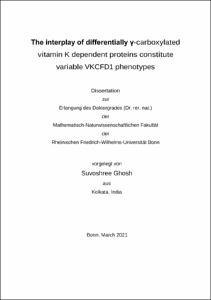The interplay of differentially γ-carboxylated vitamin K dependent proteins constitute variable VKCFD1 phenotypes

The interplay of differentially γ-carboxylated vitamin K dependent proteins constitute variable VKCFD1 phenotypes

| dc.contributor.advisor | Oldenburg, Johannes | |
| dc.contributor.author | Ghosh, Suvoshree | |
| dc.date.accessioned | 2021-11-18T15:34:07Z | |
| dc.date.available | 2021-11-18T15:34:07Z | |
| dc.date.issued | 18.11.2021 | |
| dc.identifier.uri | https://hdl.handle.net/20.500.11811/9413 | |
| dc.description.abstract | Vitamin K dependent coagulation factor deficiency type 1 (VKCFD1) is a rare hereditary bleeding disorder caused by mutations in γ-Glutamyl carboxylase (GGCX). VKCFD1 patients are treated with high dose of vitamin K, which corrects the haemostatic phenotype in most cases. In addition, these patients often exhibit non-haemostatic phenotypes such as skin hyperlaxity, skeletal and cardiac abnormalities. These phenotypes are most likely developed due to the undercarboxylation of one or more vitamin K dependent proteins. However, it remained elusive how GGCX mutations affect γ-carboxylation of VKD proteins and which undercarboxylated protein leads to the development of a specific phenotype. In this PhD thesis, I have used CRISPR/Cas9 engineered GGCX knockout HEK293T cells to evaluate the effect of 22 GGCX missense mutations on γ-carboxylation of 9 different vitamin K dependent proteins with respect to various concentrations of vitamin K. For this evaluation a specific ELISA assay was established, where only functional, γ-carboxylated VKD proteins were detected. Furthermore, a GGCX in silico model was generated, where molecular docking was performed to identify the vitamin K hydroquinone binding site. All GGCX mutations were categorized into responder and low responder mutations, thereby determining the efficiency of vitamin K supplementation. It was observed that all VKCFD1 patients have at least one vitamin K responsive GGCX allele that is able to γ-carboxylate clotting factors sufficient for a viable phenotype. For non-haemostatic phenotypes, the findings highlight that the deficiency to γ-carboxylate Gla-rich protein leads to skin hyper-laxity whereas facial dysmorphologies are caused by reduced γ-carboxylated MGP. Moreover, the vitamin K hydroquinone binding site in GGCX was identified, where mutations within this site severely affect γ-carboxylation efficiency. With these new structural and functional data, the clinical outcome of each VKCFD1 genotype can be predicted thus enabling optimized treatment strategies. | en |
| dc.language.iso | eng | |
| dc.rights | In Copyright | |
| dc.rights.uri | http://rightsstatements.org/vocab/InC/1.0/ | |
| dc.subject.ddc | 570 Biowissenschaften, Biologie | |
| dc.title | The interplay of differentially γ-carboxylated vitamin K dependent proteins constitute variable VKCFD1 phenotypes | |
| dc.type | Dissertation oder Habilitation | |
| dc.publisher.name | Universitäts- und Landesbibliothek Bonn | |
| dc.publisher.location | Bonn | |
| dc.rights.accessRights | openAccess | |
| dc.identifier.urn | https://nbn-resolving.org/urn:nbn:de:hbz:5-64490 | |
| ulbbn.pubtype | Erstveröffentlichung | |
| ulbbnediss.affiliation.name | Rheinische Friedrich-Wilhelms-Universität Bonn | |
| ulbbnediss.affiliation.location | Bonn | |
| ulbbnediss.thesis.level | Dissertation | |
| ulbbnediss.dissID | 6449 | |
| ulbbnediss.date.accepted | 27.10.2021 | |
| ulbbnediss.institute | Medizinische Fakultät / Institute : Institut für Experimentelle Hämatologie und Transfusionsmedizin (IHT) | |
| ulbbnediss.fakultaet | Mathematisch-Naturwissenschaftliche Fakultät | |
| dc.contributor.coReferee | Imhof, Diana | |
| ulbbnediss.contributor.gnd | 1248894936 |
Files in this item
This item appears in the following Collection(s)
-
E-Dissertationen (4400)




